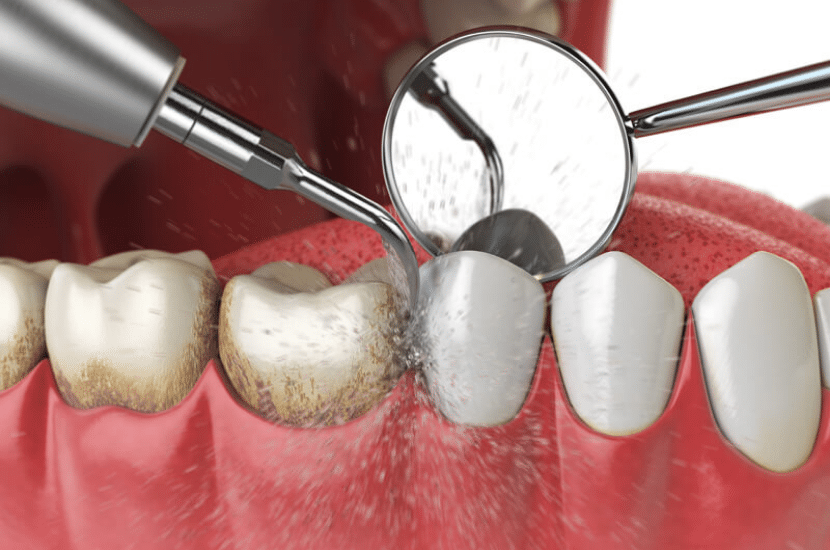
Understanding Periodontal Disease and Why Treatment Matters
Gum disease—also called periodontal disease—begins when bacteria in plaque irritate the gum tissue. In its early stage, known as gingivitis, you may experience red, swollen, or bleeding gums. If left untreated, this can progress into periodontitis, where the infection reaches deeper structures, damaging bone and connective tissue supporting your teeth.
Beyond tooth loss, periodontal disease has been linked to systemic health concerns, such as cardiovascular disease, diabetes, and respiratory conditions. That’s why timely evaluation and intervention are crucial for both your oral and overall health.
At Olive Branch Dental Columbus, we aim to detect gum disease early and treat it with care, using the latest techniques to restore healthy gum and bone support.
How We Diagnose Periodontal Disease
When you visit our clinic, we start with a comprehensive periodontal exam. This includes:
- Measuring the depth of gum pockets using a probe
- Checking for bleeding on probing
- Evaluating gum recession and mobility of teeth
- Reviewing radiographs (X-rays) to look for bone loss
These assessments help us determine whether you have gingivitis or a more advanced periodontitis, and guide us in building an individualized treatment plan.
Non-Surgical Treatments: The Foundation of Periodontal Care
In many cases, especially at earlier stages, non-surgical therapy is sufficient to control periodontal disease. Our non-surgical options include:
Scaling & Root Planing (Deep Cleaning)
This is often the cornerstone of periodontal treatment. In scaling, we remove plaque and tartar (calculus) deposits above and below the gum line. In root planing, we smooth the root surfaces so the gums can reattach more easily.
Modern tools—ultrasonic scalers and hand instruments—help ensure we thoroughly clean even the hard-to-reach areas.
Localized Antibiotics and Antimicrobial Agents
In certain cases, we may place localized antimicrobial agents (gel, fibers, or chips) into periodontal pockets to help reduce bacterial load and promote healing.
Maintenance and Re-Evaluation
After scaling and root planing, we closely monitor how your gums respond. We often schedule follow-up visits to measure pocket depth again and decide whether further treatment is needed.
Non-surgical therapy is frequently the first step—even for patients who later need surgery—because it helps reduce inflammation and improves tissue quality before more invasive procedures.
When Surgery Is Needed: Advanced Periodontal Interventions
If pockets remain deep or disease doesn’t respond fully to non-surgical therapy, surgical approaches may be necessary. Some of the surgical options we offer include:
Flap (Open) Surgery / Debridement
In this procedure, the gums are gently lifted (flapped back) so that the tooth roots and bone are fully exposed. This allows better access to remove deep deposits and shape the underlying bone. After cleaning, the gum tissues are repositioned.
Bone Grafting / Regeneration
Where bone has been lost due to periodontal disease, we may use bone graft materials (autograft, allograft, or synthetic) to promote regeneration of bone and support. Guided tissue regeneration (GTR) techniques may be used in conjunction.
Soft Tissue Grafting (Gum Grafts)
When gums have receded, exposing sensitive root surfaces, grafts of tissue (often from the palate or donor sources) help cover the exposed roots, reduce sensitivity, and improve esthetics.
Crown Lengthening
If a tooth is too deeply buried under gum tissue (for restorative or esthetic reasons), we may remove some gum and bone tissue to expose adequate tooth structure so that crowns or restorations can be placed properly.
Laser-Assisted Procedures (if available)
Some practices use laser methods to precisely remove diseased tissue, reduce bacteria, and stimulate healing with less bleeding and faster recovery. While Olive Branch Dental’s page does not explicitly mention lasers, many periodontal practices in Columbus adopt these minimally invasive options as part of their toolkit.
Personalized Treatment Planning & Patient Comfort
At Olive Branch Dental Columbus, our goal is to tailor treatment to your specific needs and comfort. Your periodontal therapy plan depends on:
- The severity and extent of disease
- Whether disease is localized or generalized
- Your medical history (e.g. diabetes, smoking, medications)
- Your preferences, esthetic goals, and financial considerations
We strive to minimize patient discomfort. Local anesthesia or sedation (if appropriate) is used during deeper procedures, and post-operative care instructions are given to promote smooth healing.
Maintenance and Long-Term Success
Treating periodontal disease isn’t a one-time event—it requires diligent maintenance. After your active therapy, you’ll be placed on a periodontal maintenance schedule, typically every 3 to 4 months. These visits include gentle cleanings, monitoring of pocket depths, and assessment for any recurrence.
Your home care is equally important. We’ll coach you on ideal brushing technique, interdental cleaning, use of antimicrobial rinses or adjuncts, and lifestyle modifications (e.g. quitting smoking, managing systemic conditions).
With consistent care, it’s possible to maintain healthy gums and prevent future progression of disease.
Why Choose Olive Branch Dental Columbus for Periodontal Care
- We emphasize early detection and conservative treatment where possible
- Our clinicians stay current with periodontal advances and tailor therapy to your needs
- We coordinate care seamlessly with restorative, cosmetic, and implant services
- Comfort and patient education are central to our philosophy
If you notice any warning signs—such as bleeding gums, persistent bad breath, gum recession, or loose teeth—don’t delay evaluation. At Olive Branch Dental, we’re ready to guide you toward healthier gums and a more confident smile through expert periodontal care in Columbus.
